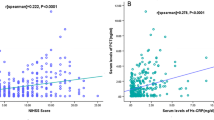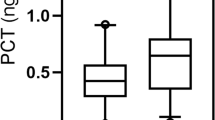Abstract
To determine whether serum procalcitonin (PCT) levels at admission were associated with short-term functional outcome after acute ischemic stroke (AIS) in a cohort Chinese sample. We prospectively studied 378 patients with AIS who were admitted within 24 h after the onset of symptoms. PCT and NIH stroke scale (NIHSS) were measured at the time of admission. Short-term functional outcome was measured by modified Rankin scale (mRS) 90 days after admission. The results indicated that the serum PCT levels were significantly higher in AIS patients as compared to normal controls (P < 0.0001). In the 114 patients with an unfavorable functional outcome, serum PCT levels were higher compared with those in patients with a favorable outcome (2.40 (IQR, 1.10–3.69) ng/mL and 0.42 (IQR, 0.10–1.05) ng/mL, respectively, P < 0.001). PCT was an independent prognostic marker of functional outcome [odds ratio (OR) 3.45 (2.29–4.77), adjusted for the NIHSS and other possible confounders] in patients with ischemic stroke, added significant additional predictive value to the clinical NIHSS score. In receiver operating characteristic curve analysis, the prognostic accuracy of PCT was higher compared to Hs-CRP and NIHSS score. PCT is an independent predictor of short-term functional outcome after ischemic stroke in Chinese sample even after correcting for possible confounding factors.



Similar content being viewed by others
References
Adams HP Jr, Bendixen BH, Kappelle LJ et al (1993) Classification of subtype of acute ischemic stroke. Definitions for use in a multicenter clinical trial. TOAST. Trial of Org 10172 in Acute Stroke Treatment. Stroke 24:35–41
Bonita R (1988) BR (1988) Modification of Rankin Scale: recovery of motor function after stroke. Stroke 19:1497–1500
Bonita R, Mendis S, Truelsen T et al (2004) The global stroke initiative. Lancet Neurol 3:391–393
Broderick JP, Brott TG, Duldner JE et al (1993) (1993), Volume of intracerebral hemorrhage. A powerful and easy-to-use predictor of 30-day mortality. Stroke 24:987–993
Brott T, Marler JR, Olinger CP et al (1989) Measurements of acute cerebral infarction: lesion size by computed tomography. Stroke 20:871–875
Castelli GP, Pognani C, Meisner M et al (2004) Procalcitonin and C-reactive protein during systemic inflammatory response syndrome, sepsis and organ dysfunction. Crit Care 8:R234
Chang L, Yan H, Li H et al (2014) N-terminal probrain natriuretic peptide levels as a predictor of functional outcomes in patients with ischemic stroke. NeuroReport 25:985–990
Emerging Risk Factors Collaboration (2010) C-reactive protein concentration and risk of coronary heart disease, stroke, and mortality: an individual participant meta-analysis. Lancet 375:132
Fluri F, Morgenthaler NG, Mueller B et al (2012) Copeptin, procalcitonin and routine inflammatory markers-predictors of infection after stroke. PLoS ONE 7:e48309
Fuentes B, Castillo J, San José B et al (2009) The prognostic value of capillary glucose levels in acute stroke: the GLycemia in acute stroke (GLIAS) study. Stroke 40:562–568
Harbarth S, Holeckova K, Froidevaux C et al (2001) Diagnostic value of procalcitonin, interleukin-6, and interleukin-8 in critically ill patients admitted with suspected sepsis. Am J Respir Crit Care Med 164:396–402
ICD-9-CM: International Classification of Diseases 9th Revision Clinical Modification[M] (1980) US Department of Health and Human Services, Public Health Service, Health Care Financing Administration
Katan M, Moon YP, DeRosa J et al (2014) Procalcitonin, copeptin and midregional pro-atrial natriuretic peptide as markers of ischemic stroke risk: the northern Manhattan study. Stroke 45(Suppl 1):A54–A54
Luyt CE, Guérin V, Combes A et al (2005) Procalcitonin kinetics as a prognostic marker of ventilator-associated pneumonia. Am J Respir Crit Care Med 171:48–53
Markaki I, Franzén I, Talani C et al (2013) Long-term survival of ischemic cerebrovascular disease in the acute inflammatory stroke study, a hospital-based cohort described by TOAST and ASCO. Cerebrovasc Dis 35:213–219
Maruna P, Nedelnikova K, Gurlich R (2000) Physiology and genetics of procalcitonin. Physiol Res 49:S57–S62
McGrane S, Girard TD, Thompson JL et al (2011) Procalcitonin and C-reactive protein levels at admission as predictors of duration of acute brain dysfunction in critically ill patients. Crit Care 15(2):R78
Meng XN, Li N, Guo DZ et al (2014) High plasma glutamate levels are associated with poor functional outcome in acute ischemic stroke. Cell Mol Neurobiol. doi:10.1007/s10571-014-0107-0
Mimoz O, Edouard AR, Samii K et al (1998) Procalcitonin and C-reactive protein during the early posttraumatic systemic inflammatory response syndrome. Intensive Care Med 24:185–188
Rost NS, Wolf PA, Kase CS et al (2001) Plasma concentration of C-reactive protein and risk of ischemic stroke and transient ischemic attack: the Framingham study. Stroke 32:2575–2579
Schiopu A, Hedblad B, Engström G et al (2012) Plasma procalcitonin and the risk of cardiovascular events and death: a prospective population-based study. J Intern Med 272:484–491
Simon L, Gauvin F, Amre DK et al (2004) Serum procalcitonin and C-reactive protein levels as markers of bacterial infection: a systematic review and meta-analysis. Clin Infect Dis 39:206–217
Slot KB, Berge E, Dorman P et al (2008) Impact of functional status at six months on long term survival in patients with ischaemic stroke: prospective cohort studies. BMJ 336:376–379
Szabo K, Kern R, Gass A et al (2001) (2001) Acute stroke patterns in patients with internal carotid artery disease: a diffusion-weighted magnetic resonance imaging study. Stroke 32:1323–1329
Tamaki K, Kogata Y, Sugiyama D et al (2008) Diagnostic accuracy of serum procalcitonin concentrations for detecting systemic bacterial infection in patients with systemic autoimmune diseases. J Rheumatol 35:114–119
Tu WJ, Dong X, Zhao SJ et al (2013) Prognostic value of plasma neuroendocrine biomarkers in patients with acute ischaemic stroke. J Neuroendocrinol 25:771–778
Vibo R, Kõrv J, Roose M et al (2007) Free Radic Res. Acute phase proteins and oxidised low-density lipoprotein in association with ischemic stroke subtype, severity and outcome. Free Radic Res 41:282–287
Wang Y, Ji H, Tong Y et al (2014) Prognostic value of serum 25-hydroxyvitamin D in patients with stroke. Neurochem Res 39:1332–1337
Wanner GA, Keel M, Steckholzer U et al (2000) Relationship between procalcitonin plasma levels and severity of injury, sepsis, organ failure, and mortality in injured patients. Crit Care Med 28:950–957
Wheeler AP, Bernard GR (1999) Treating patients with severe sepsis. N Engl J Med 340:207–214
Whiteley W, Chong WL, Sengupta A et al (2009) Blood markers for the prognosis of ischemic stroke: a systematic review. Stroke 40:e380–e389
Whiteley W, Wardlaw J, Dennis M et al (2012) The use of blood biomarkers to predict poor outcome after acute transient ischemic attack or ischemic stroke. Stroke 43:86–91
Acknowledgments
We also express our gratitude to all the patients who participated in this study, and thereby made this work possible.
Conflict of interest
The authors have no relevant potential conflicts of interest to declare.
Funding
The author(s) received no specific funding for this work.
Author information
Authors and Affiliations
Corresponding author
Rights and permissions
About this article
Cite this article
Deng, WJ., Shen, RL., Li, M. et al. Relationship Between Procalcitonin Serum Levels and Functional Outcome in Stroke Patients. Cell Mol Neurobiol 35, 355–361 (2015). https://doi.org/10.1007/s10571-014-0131-0
Received:
Accepted:
Published:
Issue Date:
DOI: https://doi.org/10.1007/s10571-014-0131-0




